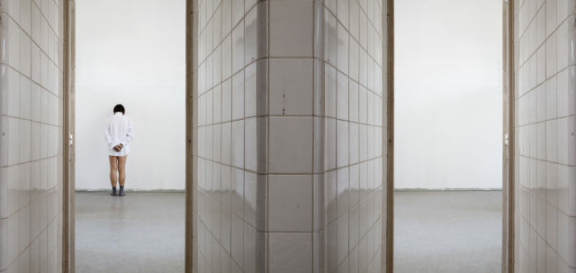
- 2010
- Paper
- Photography
- Inv. FP565
Vasco Araújo
Todos os que caem [All that fall]
Two circumstances might be highlighted in Vasco Araújo’s career that serve as formal guidelines to appreciate his oeuvre: the fact that he holds an academic background in sculpture (Faculty of Fine Arts of the University of Lisbon), and that he has a penchant for singing, namely for opera.
The former brings about an eagerness for the creation of objects and their spatialization, the latter channels that eagerness into staging, theatre, performance and narrative, presented in the form of installations.
Thematically, Araújo’s work focuses mainly on the human condition. He has mentioned in an interview with Maria João Seixas that “my work always has to do with questions of identity and gender. It has to do with people’s histories, with the overlapping of those histories and the mode through which we expose ourselves in those histories.”*
Hence, in the encounter with this artist’s work, one can discern a universe of parables and metaphors which, often grounded in classical works of literature, mythology, history or music, are then reconfigured in operative practices that subvert the original intent of these works, clearly with the aim of confronting and questioning the spectator.
The series of nineteen images that constitute Todos os que caem [All that fall] is no exception to this rule, appropriating on the one hand the title of the radio play All That Fall (1957), by Samuel Beckett, and, on the other, diverging markedly from this work’s narrative, although not from its author.
In fact, during the mid-1930s, after a depression and psychoanalytic treatment, Beckett was advised by his doctor to attend a conference series by Carl Jung in the same clinic he was being treated in. The words of this psychoanalyst would leave lasting impressions, to the point where he used a story told by Jung in All That Fall.**
Vasco Araújo’s image leads us to this universe of psychopathology, depression, and psychosis, through a character (Vasco Araújo himself) who roams semi-naked through empty halls and rooms, appropriately photographed in a deactivated pavilion at the Psychiatric Hospital Júlio de Matos in Lisbon. As such, it gives form to the author’s purpose of dramatizing the world of psychosis, trauma, abandonment and isolation.
By using bodily codes and spaces that we associate with mental illness (semi-nakedness, the contorted body posture, alienation, breakdown and confinement, the blank spaces and long hallways), this series of images also makes use of symmetry, or of the composition of two spaces in a single image, punctuated by the presence and the absence of the character, possibly suggesting the close relationship between sanity and insanity.
JO
May 2012
* SEIXAS, Maria João (2007). “O Canto Novo da Interioridade”, in AAVV (2007). BES Photo 2006 [cat.], Lisboa: Fundação Centro Cultural de Belém / Banco Espírito Santo, p. 87.
** In the play, the reference is told by the protagonist as a memory which haunts her ever since she heard a doctor of mental diseases (whose name she cannot recall) say that after quitting the treatment of a girl who for some years had gradually worsened and died shortly afterwards, he later had a revelation of the problem’s cause: she had never really been born.
| Type | Value | Unit | Section |
| Height | 160 | cm | |
| Width | 250 | cm |
| Type | Acquisition |
| Mais que a vida / Más que la vida / Larger than life - Vasco Araújo . Javier Téllez |
| Lisboa, CAM - Fundação Calouste Gulbenkian, 2010 |
| ISBN:978-972-635-215-0 |
| Exhibition catalogue |
| Mais que a vida / Más que la vida / Larger than life - Vasco Araújo . Javier Téllez |
| CAM/FCG |
| Curator: Isabel Carlos |
| 2010-05-28 a 2010-09-05 Sala de Exp.Temp. do piso 0 da Sede, Sala de Exp. Temp. do CAM e Sala Polivalente |
| 2010-09-17 a 2011-01-09 MARCO - Museu de Arte Contemporánea de Vigo |
